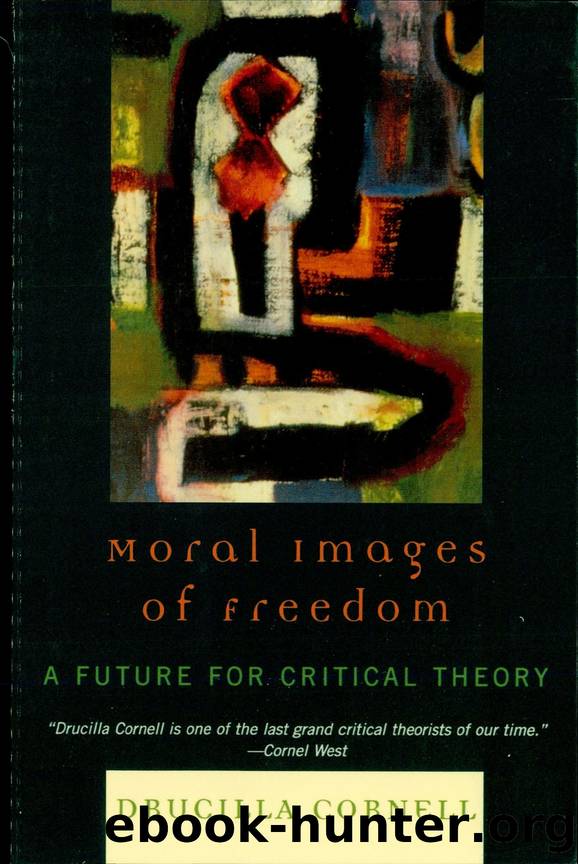Moral Images of Freedom by Cornell Drucilla

Author:Cornell, Drucilla. [Cornell, Drucilla]
Language: eng
Format: epub
ISBN: 9781461640189
Publisher: RowmanLittlefield
Published: 2013-07-12T05:00:00+00:00
For Cassirer, life and Geistâthe sensuous and the spiritualâare always mediated by one another in symbolic form. Language, as one symbolic form, is part of the sensuous world and makes the intellectual world of abstract ideas possible at the same time. This way of thinking about language affirms the unity of the sensual and spiritual which Cassirer argues is crucial for recasting the Kantian notion of the schema.
What is involved when an image is used to serve as a symbol is a complex relationship of expression, significance, and representation. The special function of symbolization must now be elaborated, and this is exactly the project Cassirer undertakes in his four-volume work. There have, of course, been many meanings of symbolization prior to Cassirerâs neo-Kantian interpretation. In regards to language, for instance, it had been supposed in the eighteenth century that the mind notes similar properties of things and then pins a label upon each one of these images. This word-label then serves to recall any one of those designated objects. But, in this understanding of symbolization in language, language serves only to recapitulate what has been given and does not have the power to reveal or develop a new meaning. This notion of a word-for-thing symbolization is precisely what Cassirer challenges. Remember here that Cassirer is always working with what he sees to be the unique distinction of our human finitude: our distinguishing between actuality and possibility. Language is inseparable from this fundamental distinction in the service it provides us. Language actually serves humans better than the thing-for-word notion of symbolization. Language is also a means to new knowledge and indeed allows us to disclose new worlds. The reason language is able to do so is that much more is involved in the function of symbolization than was defended and articulated in the eighteenth-century model of a symbol.
For Cassirer, nothing is truly a symbol if it is only a mark of something already given and enables us merely to talk about it again. The âitâ we denote with a word is only perceived in the first instance in light of our whole previous experience of the world already revealed to us in language. It is identified as what it is, even as an object necessarily in space and time by the relations of whatever is given by other known contexts of experience. There is such a whole, always present, in the moment of remaking any particular given, since that given only takes on meaning in relationship with other known contexts of experience. There is also such a whole, always present, in the moment of remaking any particular given as any symbol derives its own significance from that whole experience represented in language. For readers more familiar with Wittgenstein, Cassirer is emphasizing the point that meaning only arises in a form of life that also then represents the very meaning of its symbolic system. For Cassirer, language as symbolic form only exemplifies what is universally the case of how human beings come to know their world.
Download
This site does not store any files on its server. We only index and link to content provided by other sites. Please contact the content providers to delete copyright contents if any and email us, we'll remove relevant links or contents immediately.
The remains of the day by Kazuo Ishiguro(8828)
Tools of Titans by Timothy Ferriss(8219)
Giovanni's Room by James Baldwin(7195)
The Black Swan by Nassim Nicholas Taleb(7014)
Inner Engineering: A Yogi's Guide to Joy by Sadhguru(6728)
The Way of Zen by Alan W. Watts(6507)
Asking the Right Questions: A Guide to Critical Thinking by M. Neil Browne & Stuart M. Keeley(5649)
The Power of Now: A Guide to Spiritual Enlightenment by Eckhart Tolle(5607)
The Six Wives Of Henry VIII (WOMEN IN HISTORY) by Fraser Antonia(5397)
Astrophysics for People in a Hurry by Neil DeGrasse Tyson(5134)
Housekeeping by Marilynne Robinson(4348)
12 Rules for Life by Jordan B. Peterson(4250)
Double Down (Diary of a Wimpy Kid Book 11) by Jeff Kinney(4208)
The Ethical Slut by Janet W. Hardy(4175)
Skin in the Game by Nassim Nicholas Taleb(4164)
Ikigai by Héctor García & Francesc Miralles(4125)
The Art of Happiness by The Dalai Lama(4063)
Skin in the Game: Hidden Asymmetries in Daily Life by Nassim Nicholas Taleb(3932)
Walking by Henry David Thoreau(3894)
